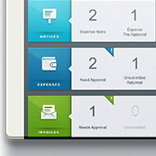
When you’re looking at new expense management software, or looking to replace your existing system, every vendor will be more than happy to highlight the key selling points of their solution. “Look at this feature!” “See how we can make your life easier.” While shiny features are certainly great, they don’t always tell the full story, and sometimes you should be more focused on what the sales people don’t say.
If you want to get the skinny on which solution will best match your organization’s needs, you need to delve a little deeper and get beyond the sales pitch. Here are six questions that you should ask every vendor during the sales process.
1. What are the limits to configuring the system?
“You can have any color as long as it’s black,” may have worked for Henry Ford, but sophisticated multinational organizations need global expense solutions that work around their needs, not the other way around. If you want to integrate with your ERP solution, set up business rules to fit your very specific requirements, or work with your existing travel management company, you need a system that can be individually configured to your unique needs.
Additionally, you probably don't expect your business processes to remain static. Modern companies strive to be agile, and want flexible configuration options that can keep up with your company's ever-changing needs. Some expense management companies charge cost-prohibitive fees to make changes after implementation, negating the ROI you were banking on.
Even if the changes can be made, how easy is it to make those changes or add a similar additional configuration?
2. Who will implement it?
It would be normal to expect that the organization you've been working with for months during the purchase process would be the same organization that implements the solution. The same company that created the solution, learned about your company's unique requirements, and worked with you to ensure that the system can be configured exactly as you need it.
That's not always the case. Sometimes, implementation - the most critical step in ensuring that you get the most benefit from your travel and expense system - is farmed out to a third party. Instead of getting the team which has developed in-depth knowledge of your requirements, you get external consultants who have to get up to speed on what you need, and then have no relationship with you once they've (eventually) finished doing the installation.
Who do you think will be able to get the job done more efficiently and effectively? Who do you think will make sure you’re 110% satisfied and happy. When you work exclusively with the vendor for implementation, you can be sure that they have a long-term interest in it being done correctly, and there won't be any "it's the software's / consultant's fault" blame game.
3. How do you handle BYOD customers?
Almost 75% of companies allow employees to use their own devices, such as smartphones and tablets, for business use. And most business users will employ a mobile device for at least part of their expense process, ranging from capturing an image of a receipt, to creating and submitting the entire expense report. If your vendor uses a mobile app to access the solution, you should ask how well it works on every device and mobile operating system that your team uses. Do the iOS, Android and Windows Mobile apps all look and operate the same, or do you need to train users differently for each platform? If there are differences between every device, this can present a huge headache for your team for training and support.
The easiest way to get around this is with a browser-based expense solution that works just as elegantly and efficiently on an old iPhone 4 as a brand-new Galaxy S7. Ask if the solution offers responsive web design, which means that every user gets the same look and feel, regardless of the device or screen size that they use. Also ask if the system uses Single Page Application technology, which minimizes the amount of data that needs to be transmitted from the browser window to the server. This means that you’ll get great performance regardless of how fast (or slow) the network is.
4. How do you handle overseas taxes?
If you have staff who travel overseas, or employees based outside your home market, you’ll need to deal with a wide range of sales and other taxation issues. Are these different tax jurisdictions automatically configured within the system, so that everything is calculated as it’s being entered, or are you expected to do this manually for every transaction?
IfIf there are only a few international users, it could end up being a compliance headache for the finance team if you have to do it all yourself. If the organization has large numbers of international employees, it’s an absolute showstopper. Any global expense solution needs to do the work for you, leaving your team to focus on big picture initiatives, not complex tax compliance issues.
5. How often is it updated… and how much will that cost?
Remember the days when software updates were those huge files that killed the system for a few hours, or when upgrading to a new version was something that both the IT team and the finance team awaited with dread?
One of the biggest benefits of software-as-a-service is that it enables innovation to be delivered constantly, and every user can benefit from it at the same time, as part of their ongoing monthly subscription. This is the way it should be. Instead of waiting months for new functionality, incremental updates are released every few weeks, so everyone can benefit from them as soon as they are ready, simply by logging onto the system in their browser. Everyone gets the latest and greatest version of the solution as part of their subscription, without having to add to subscription costs.
If you’re expected to wait for that big twice-yearly update, or the latest version will cost you extra, you’re really not getting the true benefit of cloud software.
6. What’s not included in the monthly fees?
When you see a new car being reviewed in a magazine, the manufacturer always sends the most tricked-out version, which is way more expensive than the model the dealer’s “rock bottom prices” talk about. It’s similar with some expense management systems – the demo may show all the cool new features, but you’re going to have to pay a premium for them.
Those reports about your French office’s expenses that your boss just asked for? That’s going to cost you more. OCR so that your system can automatically extract information from receipts? Yup, that’s an add-on, too.
It may sound like a cliché, but always read the fine print. Ask each vendor for a full run-down of everything that’s included and not included in the regular monthly subscription fee. It may surprise you.
If your sales person's face became ashen when you asked any of these questions, or your email "must have somehow ended up in the spam folder," or if they "had to take another call" and conveniently forgot to respond, you probably have all the answers you need.
Search
Subscribe
Latest Posts
Posts by Category
Our choice of Chrome River EXPENSE was made in part due to the very user-friendly interface, easy configurability, and the clear commitment to impactful customer service – all aspects in which Chrome River was the clear winner. While Chrome River is not as large as some of the other vendors we considered, we found that to be a benefit and our due diligence showed that it could support us as well as any large players in the space, along with a personalized level of customer care.
We are excited to be able to enforce much more stringent compliance to our expense guidelines and significantly enhance our expense reporting and analytics. By automating these processes, we will be able to free up AP time formerly spent on manual administrative tasks, and enhance the role by being much more strategic.
